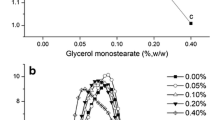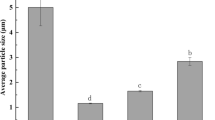Abstract
Recombined cream (RC, 23 % fat w/w) and standardised commercial cream (CC, 28 % fat w/w) were studied to understand the effects of manipulating fat globule size at the micron-/nano-scale on the stability and rheological properties of cream. All samples were adjusted to a fat: protein ratio of 5:1 and a fat: emulsifier (Tween 80) ratio of 30:1 to stabilize emulsion. For both CC and RC, different emulsions with droplet sizes covering micron- (3.9 μm), sub-micron (0.5 – 0.6 μm) and nano-metric scales (0.13 – 0.29 μm) were obtained using either the homogeniser (7/3 MPa) or the microfluidiser (85 MPa and 42 MPa). Fat globules from both RC and CC had high zeta potential values (-28 to -43 mV) and maintained their reduced size after 1 month of storage at 4 °C, providing evidence of emulsion stability. Droplet size had a significant effect on rheological characteristics of all creams produced. Nano-sized RC tended to have a rigid structure (solid/gel-like form) as compared to micron-sized RC (liquid-like form) as reflected by higher phase angle. Surprisingly, the rheological properties of CC exhibited an opposite tendency to that of RC. This implies that the observed rheological properties of CC and RC could not be fully explained by the discrepancy in droplet size. Differences in interfacial properties between RC and CC might also play a role in the rheological behaviour of the creams. Results indicated the stable high milk fat emulsions could be successfully created by reducing the globule size. These findings would be useful in understanding how micron-/nano-sized emulsions can be utilised in further application or processing of creams.




Similar content being viewed by others
References
J. Palanuwech, J.N. Coupland, Effect of surfactant type on the stability of oil-in-water emulsions to dispersed phase crystallization. Colloids Surf. A Physicochem. Eng. Asp. 223(1), 251–262 (2003)
C. Solans et al., Nano-emulsions. Curr. Opin. Colloid Interface Sci. 10(3), 102–110 (2005)
T. Tadros et al., Formation and stability of nano-emulsions. Adv. Colloid Interf. Sci. 108, 303–318 (2004)
D.J. McClements, J. Rao, Food-grade nanoemulsions: formulation, fabrication, properties, performance, biological fate, and potential toxicity. Crit. Rev. Food Sci. Nutr. 51(4), 285–330 (2011)
D.J. McClements, Edible nanoemulsions: fabrication, properties, and functional performance. Soft Matter 7(6), 2297–2316 (2011)
S.M. Jafari et al., Re-coalescence of emulsion droplets during high-energy emulsification. Food Hydrocoll. 22(7), 1191–1202 (2008)
P. Juliano et al., Enhanced creaming of milk fat globules in milk emulsions by the application of ultrasound and detection by means of optical methods. Ultrasonics - Sonochem. 18(5), 963–973 (2011)
T. Truong et al., Effects of emulsion droplet sizes on the crystallisation of milk fat. Food Chem. 145, 725–735 (2014)
T. Truong et al., SpringerBriefs in Food, Health, and Nutrition, in Effect of Milk Fat Globule Size on the Physical Functionality of Dairy Products, ed. by R.W. Hartel (Springer, New York, 2016), p. 70
P. Walstra, J.T.M. Wouters, T.J. Geurts, Dairy science and technology (CRC Press/Taylor & Francis, Boca Raton, 2005)
H.-G. Kessler, Food and bio process engineering: dairy technology (Verlag A. Kessler, München, 2002)
Z. Long et al., Effect of homogenisation and storage time on surface and rheology properties of whipping cream. Food Chem. 131(3), 748–753 (2012)
T. Truong, N. Bansal, B. Bhandari, Effect of emulsion droplet size on foaming properties of milk fat emulsions. Food Bioprocess Technol. 7(12), 3416–3428 (2014)
L. Bai, D.J. McClements, Development of microfluidization methods for efficient production of concentrated nanoemulsions: Comparison of single- and dual-channel microfluidizers. J. Colloid Interface Sci. 466, 206–212 (2016)
Olsson, A. and A. Mamic, Method Development for Fractionation of Milk Fat Globules-For improvement of cream functionality. 2015.
M.C. Michalski et al., Microfiltration of raw whole milk to select fractions with different fat globule size distributions: process optimization and analysis. J. Dairy Sci. 89(10), 3778–3790 (2006)
T. Leong et al., Ultrasonically enhanced fractionation of milk fat in a litre-scale prototype vessel. Ultrason. Sonochem. 28, 118–129 (2016)
D.W. Olson, C.H. White, R.L. Richter, Effect of pressure and fat content on particle sizes in microfluidized milk. J. Dairy Sci. 87(10), 3217–3223 (2004)
Q. Zhao et al., Effects of sodium caseinate and whey proteins an whipping properties and texture characteristics of whipped cream. J. Food Process Eng. 31(5), 671–683 (2008)
C.I.E. Ciron et al., Comparison of the effects of high-pressure microfluidization and conventional homogenization of milk on particle size, water retention and texture of non-fat and low-fat yoghurts. Int. Dairy J. 20(5), 314–320 (2010)
L. Lee, I.T. Norton, Comparing droplet breakup for a high-pressure valve homogeniser and a Microfluidizer for the potential production of food-grade nanoemulsions. J. Food Eng. 114(2), 158–163 (2013)
C. Qian, D.J. McClements, Formation of nanoemulsions stabilized by model food-grade emulsifiers using high-pressure homogenization: Factors affecting particle size. Food Hydrocoll. 25(5), 1000–1008 (2011)
P. Walstra, Dairy technology : principles of milk properties and processes. Food science and technology (Marcel Dekker, New York, 1999), p. 90. xvii, 727
H. Mulder, P. Walstra, The milk fat globule : emulsion science as applied to milk products and comparable foods (Pudoc, Wageningen, 1974), p. 292
D.J. McClements, Ultrasonic determination of depletion flocculation in oil-in-water emulsions containing a non-ionic surfactant. Colloids Surf. A Physicochem. Eng. Asp. 90(1), 25–35 (1994)
S. Mun, E.A. Decker, D.J. McClements, Influence of droplet characteristics on the formation of oil-in-water emulsions stabilized by surfactant-chitosan layers. Langmuir 21(14), 6228–6234 (2005)
M.C. Michalski et al., Native vs. damaged milk fat globules: membrane properties affect the viscoelasticity of milk gels. J. Dairy Sci. 85(10), 2451–2461 (2002)
O. Ménard et al., Buffalo vs. cow milk fat globules: Size distribution, zeta-potential, compositions in total fatty acids and in polar lipids from the milk fat globule membrane. Food Chem. 120(2), 544–551 (2010)
J.I. Acedo-Carrillo et al., Zeta potential and drop growth of oil in water emulsions stabilized with mesquite gum. Carbohydr. Polym. 65(3), 327–336 (2006)
Q. Gan et al., Modulation of surface charge, particle size and morphological properties of chitosan–TPP nanoparticles intended for gene delivery. Colloids Surf. B: Biointerfaces 44(2–3), 65–73 (2005)
P. Calvo, J.L. Vila-Jato, M.J. Alonso, Comparative in vitro evaluation of several colloidal systems, nanoparticles, nanocapsules, and nanoemulsions, as ocular drug carriers. J. Pharm. Sci. 85(5), 530–536 (1996)
J.M. de Morais et al., Characterization and evaluation of electrolyte influence on canola oil/water nano-emulsion. J. Dispers. Sci. Technol. 27(7), 1009–1014 (2006)
P. Walstra, R. Jenness, Dairy Chemistry and Physics (John Wiley, New York, 1984)
E.A. Collins, D.J. Hoffmann, P.L. Soni, Rheology of PVC dispersions. I. Effect of particle size and particle size distribution. J. Colloid Interface Sci. 71(1), 21–29 (1979)
D.J. McClements, Food emulsions: principles, practice, and techniques (CRC Press, Boca Raton, 1999)
S.R. Derkach, Rheology of emulsions. Adv. Colloid Interf. Sci. 151(1), 1–23 (2009)
Y. Otsubo, R.K. Prud’homme, Rheology of oil-in-water emulsions. Rheol. Acta 33(1), 29–37 (1994)
D.F. Darling, D.W. Butcher, Milk-fat globule membrane in homogenized cream. J. Dairy Res. 45(2), 197 (1978)
I. Heertje, Structure and function of food products: a review. Food Struct. 1(1), 3–23 (2014)
D.W. Everett, N.F. Olson, Dynamic rheology of renneted milk gels containing fat globules stabilized with different surfactants. J. Dairy Sci. 83(6), 1203–1209 (2000)
F. Speroni et al., Gelation of soybean proteins induced by sequential high-pressure and thermal treatments. Food Hydrocoll. 23(5), 1433–1442 (2009)
J. Weiss, D.J. McClements, Influence of ostwald ripening on rheology of oil-in-water emulsions containing electrostatically stabilized droplets. Langmuir 16(5), 2145–2150 (2000)
Steffe, J.F., Rheological methods in food process engineering. 1996: Freeman press.
Acknowledgments
The authors would like to thank ARC Dairy Innovation Hub for the financial support during this research. We thank Dr. Martin Palmer for his advice during the course of this research and in the preparation of this manuscript.
Author information
Authors and Affiliations
Corresponding author
Rights and permissions
About this article
Cite this article
Hussain, H., Truong, T., Bansal, N. et al. The Effect of Manipulating Fat Globule Size on the Stability and Rheological Properties of Dairy Creams. Food Biophysics 12, 1–10 (2017). https://doi.org/10.1007/s11483-016-9457-0
Received:
Accepted:
Published:
Issue Date:
DOI: https://doi.org/10.1007/s11483-016-9457-0




